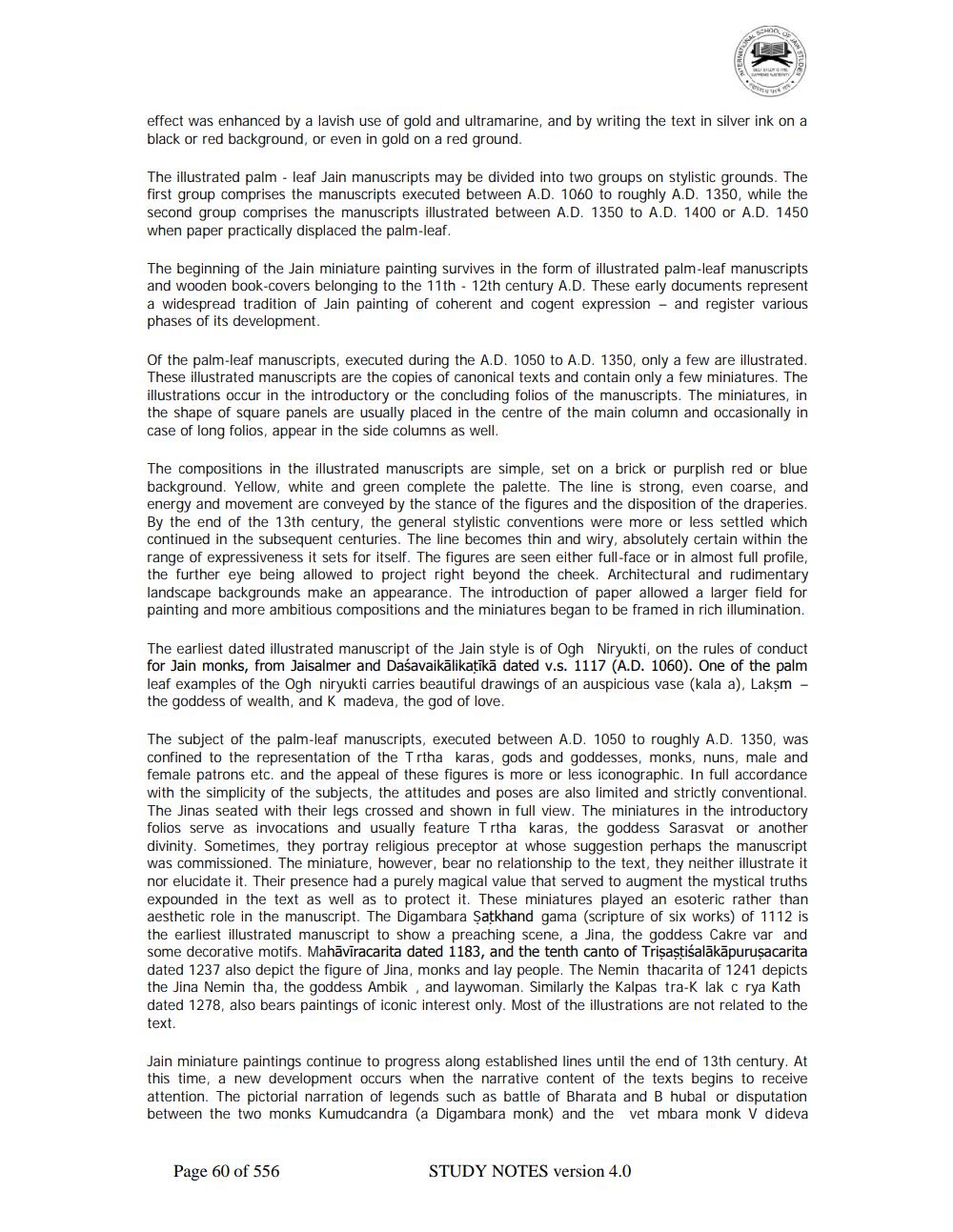________________
effect was enhanced by a lavish use of gold and ultramarine, and by writing the text in silver ink on a black or red background, or even in gold on a red ground.
The illustrated palm leaf Jain manuscripts may be divided into two groups on stylistic grounds. The first group comprises the manuscripts executed between A.D. 1060 to roughly A.D. 1350, while the second group comprises the manuscripts illustrated between A.D. 1350 to A.D. 1400 or A.D. 1450 when paper practically displaced the palm-leaf.
The beginning of the Jain miniature painting survives in the form of illustrated palm-leaf manuscripts and wooden book-covers belonging to the 11th 12th century A.D. These early documents represent a widespread tradition of Jain painting of coherent and cogent expression - and register various phases of its development.
Of the palm-leaf manuscripts, executed during the A.D. 1050 to A.D. 1350, only a few are illustrated. These illustrated manuscripts are the copies of canonical texts and contain only a few miniatures. The illustrations occur in the introductory or the concluding folios of the manuscripts. The miniatures, in the shape of square panels are usually placed in the centre of the main column and occasionally in case of long folios, appear in the side columns as well.
The compositions in the illustrated manuscripts are simple, set on a brick or purplish red or blue background. Yellow, white and green complete the palette. The line is strong, even coarse, and energy and movement are conveyed by the stance of the figures and the disposition of the draperies. By the end of the 13th century, the general stylistic conventions were more or less settled which continued in the subsequent centuries. The line becomes thin and wiry, absolutely certain within the range of expressiveness it sets for itself. The figures are seen either full-face or in almost full profile, the further eye being allowed to project right beyond the cheek. Architectural and rudimentary landscape backgrounds make an appearance. The introduction of paper allowed a larger field for painting and more ambitious compositions and the miniatures began to be framed in rich illumination.
The earliest dated illustrated manuscript of the Jain style is of Ogh Niryukti, on the rules of conduct for Jain monks, from Jaisalmer and Daśavaikālikaṭīkā dated v.s. 1117 (A.D. 1060). One of the palm leaf examples of the Ogh niryukti carries beautiful drawings of an auspicious vase (kala a), Lakṣm - the goddess of wealth, and K madeva, the god of love.
The subject of the palm-leaf manuscripts, executed between A.D. 1050 to roughly A.D. 1350, was confined to the representation of the Trtha karas, gods and goddesses, monks, nuns, male and female patrons etc. and the appeal of these figures is more or less iconographic. In full accordance with the simplicity of the subjects, the attitudes and poses are also limited and strictly conventional. The Jinas seated with their legs crossed and shown in full view. The miniatures in the introductory folios serve as invocations and usually feature Trtha karas, the goddess Sarasvat or another divinity. Sometimes, they portray religious preceptor at whose suggestion perhaps the manuscript was commissioned. The miniature, however, bear no relationship to the text, they neither illustrate it nor elucidate it. Their presence had a purely magical value that served to augment the mystical truths expounded in the text as well as to protect it. These miniatures played an esoteric rather than aesthetic role in the manuscript. The Digambara Şatkhand gama (scripture of six works) of 1112 is the earliest illustrated manuscript to show a preaching scene, a Jina, the goddess Cakre var and some decorative motifs. Mahāvīracarita dated 1183, and the tenth canto of Triṣastiśalākāpuruşacarita dated 1237 also depict the figure of Jina, monks and lay people. The Nemin thacarita of 1241 depicts the Jina Nemin tha, the goddess Ambik, and laywoman. Similarly the Kalpas tra-K lak c rya Kath dated 1278, also bears paintings of iconic interest only. Most of the illustrations are not related to the text.
Jain miniature paintings continue to progress along established lines until the end of 13th century. At this time, a new development occurs when the narrative content of the texts begins to receive attention. The pictorial narration of legends such as battle of Bharata and B hubal or disputation between the two monks Kumudcandra (a Digambara monk) and the vet mbara monk V dideva
Page 60 of 556
STUDY NOTES version 4.0




